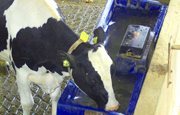
Click here to see other NNYADP Dairy Research project results/reports
Northern New York Agriculture
By karalynn

Click here to see other NNYADP Dairy Research project results/reports
By karalynn
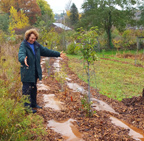
FreshPlaza.com has posted a story on the NNYADP superfruits research with comments from project participant Dani Baker, at right showing a new honeyberry planting, at Cross Island Farms, Wellesley Island, N.Y.
Click here to read the announcement of the latest project results
Click here to read the NNYADP 2019 New Fruits for NNY project report
By karalynn
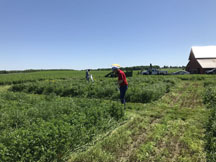
Northern N.Y.: June 29, 2020. Alfalfa-grass quality trials in northern New York State are evaluating European meadow fescue varieties never before tested in North America and the first modern variety of meadow fescue developed in the U.S. from plants isolated in southwestern Wisconsin. These trials support New York’s dairy industry by examining a forage crop grown to feed milking dairy cows.
The Northern New York Agricultural Development Program (NNYADP) is funding the research that is being conducted by the Cornell University research team of Debbie J.R. Cherney, Ph.D., and Jerry H. Cherney, Ph.D. The latest results report of trials on farms in NNY is posted under the Research: Field Crops: Grasses tab at www.nnyagdev.org. (Click here to go to https://nnyagdev.org/wp-content/uploads/2020/04/NNYADP2020AlfalfaGrassReportFINAL.pdf).
The NNYADP trials are evaluating the opportunity to add European varieties of meadow fescue, a winter-tolerant perennial grass, to alfalfa plantings. The goal is to successfully grow meadow fescue as 20-30 percent of a mix with alfalfa under northern New York conditions. The spring harvest may account for up to half of the total forage yield of a crop grown to feed milking dairy cows.
“These regional trials are providing insight into alfalfa-grass combinations that can increase forage fiber digestibility enough to significantly increase milk income using balanced rations,” Debbie J.R. Cherney said.
“Many of the European meadow fescue varieties we are evaluating were developed in harsher environments than those in northern New York, so they should overwinter successfully here, but we need to evaluate the opportunity for yield and quality and their competitiveness with alfalfa,” Jerry Cherney explained.
The U.S.-bred meadow fescue in the NNYADP trial showed the highest neutral detergent fiber digestibility of the 19 varieties trialed in 2019. The seed supply of the variety known as Hidden Valley for the farm from which the variety has originated sold out almost immediately after it became available. The NNYADP trial data indicated that the Hidden Valley meadow fescue grew at the desired grass percentage in tandem with alfalfa.
Six farms in northern New York are participating in these forage research trials. In 2019, one farm harvested the trial plots twice, another farm harvested three times, and another participant harvested four times. A fourth farm successfully established a new seeding in 2019. Two additional farms joined the project in 2020, seeding trials with three new meadow fescue varieties released by a German seed company.
Harvested samples are assayed for alfalfa-grass percentage and alfalfa and grass quality in terms of crude protein, lignin, and fiber; dry matter yield; and evaluated for the influence of soil type, drainage, fertilization, seeding rate, and harvesting schedule on crop quality.
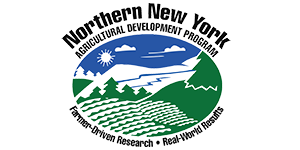
Funding for the Northern New York Agricultural Development Program is supported by the New York State Legislature and administered by the New York State Department of Agriculture and Markets. Learn more at www.nnyagdev.org.
Click here to read the 2019 NNYADP Maximizing Alfalfa and Grass Quality of Mixes report
By karalynn
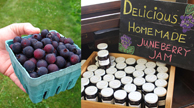
Willsboro, N.Y. ; June 16, 2020. Three high-antioxidant, high-economic value “superfruits:” juneberry, honeyberry and aronia berry are the focus of research funded by Northern New York Agricultural Development Program (NNYADP). These fruit crops represent significant income potential from fresh market and value-added sales in New York State. They are northern climate-tolerant and have proven to be consumer-friendly in other areas of the U.S. and globally. NNYADP-funded grower trials of the three fruits are evaluating how well they adapt to and thrive under New York growing conditions.
Seven farms in northern New York are hosting commercial grower trials of the three fruits. The “Establishing New Commercial Fruit Crops for Northern NY” report with evaluations from those farm trials is posted under the Research: Horticulture and Local Foods tab at www.nnyagdev.org. The NNYADP report includes notes on 11 commercial varieties, four ornamental varieties, and nine wild-collected varieties of juneberry; 15 varieties of honeyberry; and four commercial varieties and two ornamental varieties of aronia berry.
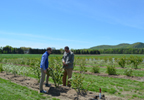
Juneberry is a blueberry-like fruit rich in calcium, fiber, iron, manganese and protein. In 2013, when the NNYADP provided funding to establish a Juneberry nursery of commercially-available and wild-collected varieties at the Willsboro Research Farm, Willsboro, New York, this historically-significant fruit was considered a New York State endangered species.
“Two of the 24 juneberry varieties planted at the Willsboro Research Farm were fruiting standouts in 2019, with almost triple their fruit yield over 2018. We are eager to see how they perform in 2020 and if they may be alternating a heavier fruiting year with a light fruiting year,” said Michael H. Davis, Ph.D., farm manager of the Cornell University Willsboro Research Farm.
Davis added that the fruit harvested from the young wild-collected juneberry plants is smaller compared to some of the commercial varieties, and the ornamental varieties appeared to favor healthy plant growth over fruit production in 2019.

Honeyberry, a member of the honeysuckle family, and aronia berry, of the rose family, were added to the NNYADP-funded novel fruit project in 2018, with trials planted at the Willsboro farm and on regional farms.
“Honeyberry, referred to by the Japanese as ‘the elixir of longevity,’ has seen a surge in public interest with the development of varieties adapted to a cooler climate, and offers New York growers an exciting new specialty fruit for fresh market sales,” said Davis.
“Aronia berry has been labeled a ‘superfood’ for its exceedingly high antioxidant and other beneficial phytonutrient content, and for the more than 60 value-added processing opportunities that support its standing as a multi-million dollar industry,” Davis explained.
Davis leads the novel fruits NNYADP research in cooperation with noted juneberry researcher and biologist Michael B. Burgess, Ph.D., with SUNY Plattsburgh. Cornell University Horticulture Professor Marvin Pritts, Ph.D., is a collaborator.
The 2019 NNYADP novel fruits project report notes that a biocontrol nematode application was made to manage rose chafers and Japanese beetle in the juneberry trial at the Willsboro farm. With NNYADP support, the science for using insect-attacking nematodes was initially created for managing an alfalfa crop pest. The protocol developed in northern NY has since been applied to a number of crops in multiple states.

Funding for the Northern New York Agricultural Development Program is supported by the New York State Legislature and administered by the New York State Department of Agriculture and Markets. Learn more at www.nnyagdev.org.
By karalynn
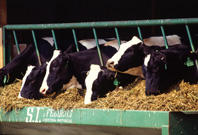
Chazy, N.Y.; June 12, 2020. Dairy farms can take simple measures to reduce the impact of heat stress on dairy cows and protect their milk production, according to research funded by the Northern New York Agricultural Development Program (NNYADP) and conducted by the W. H. Miner Agricultural Research Institute. The latest results report, comparing heat abatement systems on four dairy farms in northern New York, is posted under the Research: Dairy tab at www.nnyagdev.org.
“This research addresses climatic trends that create episodic bouts of heat stress that do not allow dairy animals time to acclimate. We are working with regional farms to develop a science-based understanding of heat stress that will help farmers enhance their heat abatement systems to increase cow comfort and maintain strong milk production,” said Miner Institute Director of Research Katie Ballard.
On one of the four farms in the NNYADP-funded study, improving air movement through the barn resulted in one hour more of cow lying time during hot weather.
“A one-hour increase in lying time represents the opportunity for 2 to 3-and-a-half more pounds of milk per day per cow,” Ballard said.
The farm increased the downward angle of fans over stall beds and closed doors at one end of the barn to create more air movement within the cow pens. Wind speed directed over the cows and water availability appeared to be key factors that improved cooling during hot weather.
The average internal, or reticular, body temperature of the cows on the farm increased by only 0.4 degrees Fahrenheit during hot weather and showed little fluctuation during the day with just slightly elevated media reticular temperature on the hottest days.
On three farms, the action of milking and/or moving cows to a holding area with fans and sprinklers appeared to reduce the cows’ body temperature. Heat abatement measures on two of the farms were effective during mild heat events when the humidity index was below 72.

“When temperature and humidity rise to certain levels, taking measures to cool your cows helps maintain their dry matter intake and rumination which translates to maintaining milk production. Cooling also encourages lying time which helps reduce lameness,” Ballard noted. “Water availability also plays a critical role in helping cows maintain a comfortable core body temperature.”
The results of earlier NNYADP heat stress research conducted on the participating farms showed that periods of heat stress decreased bulk tank milk protein levels. Greater than 40 percent of the variability in milk protein percentage was associated with the temperature humidity index on farms where cows appeared the most vulnerable to heat stress during hot weather events in 2016 to 2018.
Researchers with Ohio State University and the University of Illinois have estimated that heat stress in cows costs the U.S. dairy industry approximately $900 million in economic losses annually.
 Funding for the Northern New York Agricultural Development Program is supported by the New York State Legislature and administered by the New York State Department of Agriculture and Markets. Learn more at www.nnyagdev.org.
Funding for the Northern New York Agricultural Development Program is supported by the New York State Legislature and administered by the New York State Department of Agriculture and Markets. Learn more at www.nnyagdev.org.